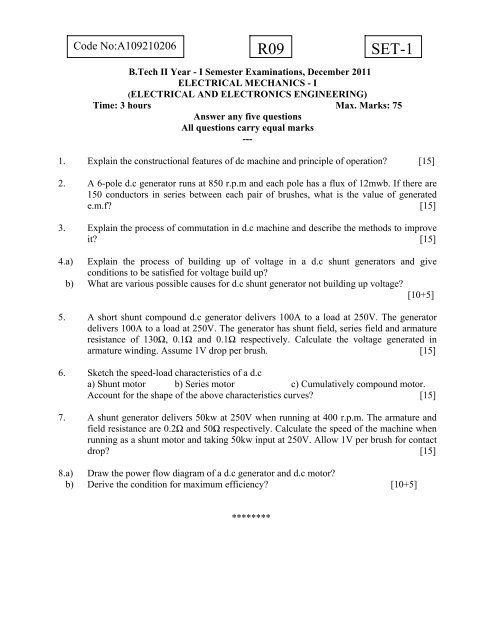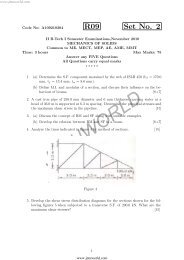R09 SET-1
a109210206 electrica.. - sitech.ac.in
a109210206 electrica.. - sitech.ac.in
Create successful ePaper yourself
Turn your PDF publications into a flip-book with our unique Google optimized e-Paper software.
Code No:A109210206<strong>R09</strong><strong>SET</strong>-1B.Tech II Year - I Semester Examinations, December 2011ELECTRICAL MECHANICS - I(ELECTRICAL AND ELECTRONICS ENGINEERING)Time: 3 hours Max. Marks: 75Answer any five questionsAll questions carry equal marks---1. Explain the constructional features of dc machine and principle of operation? [15]2. A 6-pole d.c generator runs at 850 r.p.m and each pole has a flux of 12mwb. If there are150 conductors in series between each pair of brushes, what is the value of generatede.m.f? [15]3. Explain the process of commutation in d.c machine and describe the methods to improveit? [15]4.a) Explain the process of building up of voltage in a d.c shunt generators and giveconditions to be satisfied for voltage build up?b) What are various possible causes for d.c shunt generator not building up voltage?[10+5]5. A short shunt compound d.c generator delivers 100A to a load at 250V. The generatordelivers 100A to a load at 250V. The generator has shunt field, series field and armatureresistance of 130Ω, 0.1Ω and 0.1Ω respectively. Calculate the voltage generated inarmature winding. Assume 1V drop per brush. [15]6. Sketch the speed-load characteristics of a d.ca) Shunt motor b) Series motor c) Cumulatively compound motor.Account for the shape of the above characteristics curves? [15]7. A shunt generator delivers 50kw at 250V when running at 400 r.p.m. The armature andfield resistance are 0.2Ω and 50Ω respectively. Calculate the speed of the machine whenrunning as a shunt motor and taking 50kw input at 250V. Allow 1V per brush for contactdrop? [15]8.a) Draw the power flow diagram of a d.c generator and d.c motor?b) Derive the condition for maximum efficiency? [10+5]********
Code No:A109210206<strong>R09</strong><strong>SET</strong>-2B.Tech II Year - I Semester Examinations, December 2011ELECTRICAL MECHANICS - I(ELECTRICAL AND ELECTRONICS ENGINEERING)Time: 3 hours Max. Marks: 75Answer any five questionsAll questions carry equal marks---1. Draw a neat sketch of a d.c generator. State the function of each part and explain theprinciple of operation as a motor and generator? [15]2. A 4-pole lap-wound dc armature has a bore diameter of 0.7metre. It has 560 conductorsand the ratio of pole arc/pole pitch is 0.63. If the armature is running at 600 r.p.m. and theflux density in the air gap is 1.2 wb/m 2 . Determine the induced emf in the armature ifeffective length of armature conductor is 20cm. [15]3. Explain the followingi) period of commutation ii) reactance voltage during commutationiii) emf commutation iv) resistance commutation. [15]4.a) What are the different types of d.c generators according to the ways in which fields areexcited? Show the connection diagram of each type?b) Explain the process of building up of voltage in a d.c shunt generators and giveconditions to be satisfied for voltage build up? [10+5]5. A 250V shunt motor runs at 1,000 rpm at no load and takes 8A. The total armature andshunt field resistance are respectively 0.2Ω and 250Ω. Calculate the speed when loadedand taking 50A. Assume the flux to be constant. [15]6. What are the general methods of speed control of d.c motors and explain them briefly?[15]7. A 220-V, d.c series motor is running at a speed of 800 r.p.m and draws 100A. Calculateat what speed the motor will run when developing half the rated torque. Total resistanceof the armature and field is 0.1Ω. Assume that the magnetic circuit is unsaturated. [15]8. What are the drawbacks of three-point starter? Describe a four-point starter with a neatsketch? [15]********
Code No:A109210206<strong>R09</strong><strong>SET</strong>-3B.Tech II Year - I Semester Examinations, December 2011ELECTRICAL MECHANICS - I(ELECTRICAL AND ELECTRONICS ENGINEERING)Time: 3 hours Max. Marks: 75Answer any five questionsAll questions carry equal marks---1.a) Discuss the principle of operation of d.c machine as a motor and as a generator?b) Derive the expression of emf generated in case of generator from the first principles?[10+5]2. An 8-pole lap-wound d.c generator armature has 960 conductors, a flux of 40mwb and aspeed of 400 r.p.m. Calculate the e.m.f generated on open circuit. If the same armature iswave wound, at what speed must it be driven to generate 400V? [15]3.a) What do you understand by demagnetizing and cross magnetizing effects of armaturereaction in a d.c machine?b) Define commutation. Explain the process of commutation in d.c generators with neatsketches? [9+6]4. Explain the process of building up of voltage in d.c shunt generator? What is itssignificance? How O.C.C. is being drawn for shunt generator? [15]5. A 25kw, 250V dc shunt generator has armature and field resistance of 0.06Ω and 100Ωrespectively. Determine the total armature power developed when workinga) as generator delivering 25kw outputb) as motor taking 25kw input. [15]6. Discuss the different methods of speed control of d.c motor with neat circuit diagram.[15]7. A 4-pole, 250-V, wave-connected shunt motor gives 10kw when running at 1000 r.p.mand drawing armature and field currents of 60A and 1A respectively. It has 560conductors. Its armature resistance is 0.2Ω. Assuming a drop of 1V per brush. Determinea) total torque b) useful torque c) useful flux per poled) rotational losses e) efficiency [15]8. Describe the Swinburne’s test with the help of a neat diagram to find out the efficiency ofd.c machine. What are the main advantages and disadvantages of this test? [15]********
Code No:A109210206<strong>R09</strong><strong>SET</strong>-4B.Tech II Year - I Semester Examinations, December 2011ELECTRICAL MECHANICS - I(ELECTRICAL AND ELECTRONICS ENGINEERING)Time: 3 hours Max. Marks: 75Answer any five questionsAll questions carry equal marks---1.a) Explain how ac voltage is converted to dc voltage in a generator?b) Explain clearly the necessities of commutator arrangement in dc generators?c) Derive the expression of emf generated in case of dc machine. [15]2. A 4-pole generator has an induced emf of 262V when driven at a speed of 400rpm. Thearmature is lap wound and has 652 conductors, its resistance being 0.15Ω. The bore ofthe pole shoe is 42cm diameter; the pole subtends an angle of 60 0 and is 20cm long.Calculate the flux density in the air gap. [15]3. What is armature reaction? Describe the effects of armature reaction on the operation ofd.c machine. How armature reaction is minimized? [15]4. Distinguish between self excited and separately excited d.c generators. How is selfexcitedd.c generators classified? Give their connection diagram? [15]5. A shunt generator gives a full-load output of 30kw at a terminal voltage of 200V. Thearmature and shunt field resistance are 0.05Ω and 50Ω respectively. The iron and frictionlosses are 1000w. Calculatea) generated e.m.f b) copper losses c) efficiency [15]6. Explain what is meant by back e.m.f. Explain the principle of torque production in d.cmotor and also derive the expression of torque? [15]7. A d.c shunt machine, connected to 250V, has an armature resistance of 0.12Ω andresistance of the field circuit is 100Ω. Find the ratio of the speed as a generator to thespeed as a motor, the line current in each case being 80A. [15]8. Explain Hopkinson’s test and corresponding circuit diagram and procedure for efficiencycalculation as motor and generator? [15]********






